
Viking Names
Car Colston
The first element of Colston, in the Bingham Wapentake of Nottinghamshire, is probably the Old Norse male personal name Kolr combined with the Old English element tun ‘an enclosure; a farmstead; a village; an estate’. Thus it is an Anglo-Scandinavian hybrid name. The later prefix Car was added to distinguish this from Colston Bassett. Early spellings suggest that this developed from Old Norse kirkja, ‘church’, in its Middle English form kirk(e). Later this was undoubtedly confused with the word carr (Middle English ker), ‘marshland’, common in Nottinghamshire place-names.
Read More
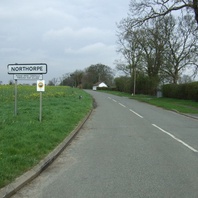
Viking Names
Northorpe
Northorpe, in the West Riding of Lindsey of Lincolnshire was originally a simplex place-name from Old Norse þorp ‘outlying farm, settlement’. Old English norð ‘north, northern’ was prefixed to distinguish Northorpe from Southorpe, which is now a deserted medieval village.
Read More
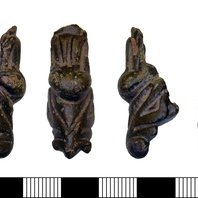
Viking Objects
Zoomorphic Stirrup Terminal (LEIC-F1C6D4)
This example of an Anglo-Scandinavian stirrup terminal features a beast-like form with a projecting snout and large flared nostrils.
Read More

Viking Names
Hunhild
Húnhildr is a postulated Old Norse female name of possible Anglo-Scandinavian origin. The first element of the name is Hún- of doubtful origin either from Old Norse húnn ‘bear-cub’ or perhaps Primitive Scandinavian hūn ‘high’. The second element of the name is –hildr ‘battle’. The name appears to be the first element in the field-name Hunildehus in Wildmore, Lincolnshire, which was recorded c. 1200.
Read More
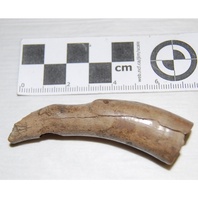
Viking Objects
Zoomorphic Knife Handle (L.A67.1864.2.0)
This bone knife handle was carved into the head of a dragon with the snout broken off. This handle is typical of the sorts of small knives that people carried for everyday use in the Viking Age. They would have been worn suspended from a belt or hung from a brooch. As general utility knives, they would have been used for everything from eating to trimming one’s nails.
Read More
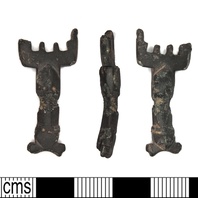
Viking Objects
Anglo-Scandinavian Key (LEIC-76C229)
Slide keys such as this example are generally known as ‘Viking keys’ due to similarities in shape with excavated examples. However, its T-shaped projections at the base have no identified parallels but the design could possibly show Anglo-Scandinavian influence. Keys were not only practical items but also symbols of status. Women often carried the keys to the family’s chests of valuables. They are also often buried with keys, representing their authority in the household. See also the blog post on keys in the Viking Age.
Read More
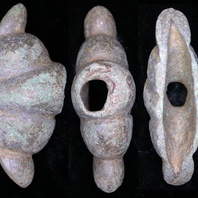
Viking Objects
Sword Pommel (LEIC-6D2448)
This copper-alloy sword pommel is made up of five lobes and is classed as a Petersen L type VI. Sword pommels were used to counter balance a sword as well as provide a decorative feature. In many cases they are the only method of identifying sword typologies.
Read More
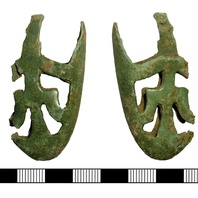
Viking Objects
Scabbard Chape (NLM-5BD697)
The incomplete openwork tongue-shaped front plate of this chape is decorated with at least six asymmetrical apertures and resembles similar chapes with ‘Birka Falcon’ decoration.
Read More
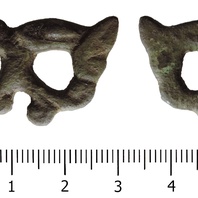
Viking Objects
Zoomorphic Mount (DENO-7E523C)
This example of a copper-alloy openwork zoomorphic mount, strap fitting or harness fitting, is decorated with the head of an animal in profile.
Read More
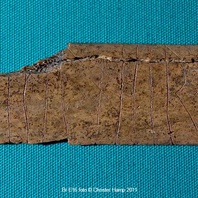
Viking Objects
Rune Inscribed Rib (LCNCC : 1999.103.104)
Runes were used not only for monumental inscriptions, or to mark ownership of valuable objects, but also in more informal contexts. In this case the animal bone suggests an after-dinner pastime after a good meal in the Anglo-Scandinavian trading centre of Lincoln. The runes read ——l × hitir × stin × … Only two words of the Old Norse inscription can be read with certainty, and even so they are ambiguous. One possible interpretation is ‘[someone] is heating a stone’ the other is ‘[someone] is called Stein’. The bone is fragmentary, but the inscription may never have been intended to make much sense. The object dates from around the 10th century. It is one of only three runic inscriptions from the East Midlands.
Read More
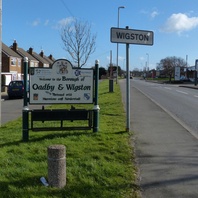
Viking Names
Wigston Magna
Wigston Magna, in the Guthlaxton Hundred of Leicestershire, is an Anglo-Scandinavian hybrid from the Old Norse male personal name Víkingr and the Old English element tun ‘an enclosure; a farmstead; a village; an estate’. Alternatively the first element might be the Old Norse appellative víkingr ‘a viking’, the probably source of the personal name. It has also been suggested that the first element may be the Old English male personal name Wicing or Old English wicing ‘a pirate, a viking’; however, these suggestions are doubtful because the length of the initial vowels of these elements are uncertain, therefore, the Old Norse male personal name is generally accepted as the first element. The Medieval Latin affix Magna ‘big, great’ arose when there was confusion between forms from Wigston Magna and Wigston Parva, which have different etymologies and development, around the the sixteenth century. Some forms of the name also have the affix with two steples because Wigston Magna possessed two medieval churches. Wigston Magna is also known as Wigston and is a joint parish with Oadby.
